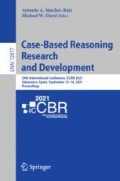Abstract
Ancient oracle bone inscriptions (OBIs) are important Chinese cultural artefacts, which are difficult and time-consuming to decipher even by the most expert paleographers and, as a result, a large proportion of excavated OBIs remain unidentified. In practice, OBIs are deciphered by translating between different writing systems; Chinese writing systems have evolved over time and ancient OBIs can be deciphered by translating their inscriptions to a known inscription in an adjacent writing system, but this is a complex and time-consuming process. In this paper we propose a novel case-based system, to support this task, allowing a paleographer to present an unknown inscription (image) as a query, to receive a set of similar images from an adjacent writing system with associated scholarly information, and so help guide the deciphering of the query. One important contribution of this work involves the use of an auto-encoder to learn suitable image representations to capture the relationship between two adjacent writing systems. We demonstrate the effectiveness of this approach using a novel, purpose-built case base, and discuss its use in a paleographic setting.
Access this chapter
Tax calculation will be finalised at checkout
Purchases are for personal use only
References
Artetxe, M., Labaka, G., Agirre, E., Cho, K.: Unsupervised neural machine translation. arXiv preprint arXiv:1710.11041 (2017)
Boltz, W.G.: Early Chinese writing. World Archaeol. 17(3), 420–436 (1986)
Brown, P.F., et al.: A statistical approach to French/English translation. In: RIAO, pp. 810–829 (1988)
Collins, B., Cunningham, P., Veale, T.: An example-based approach to machine translation. In: Conference of the Association for Machine Translation in the Americas (1996)
Derpanis, K.G.: Mean shift clustering. In: Lecture Notes, p. 32 (2005)
Dorr, B.J., Jordan, P.W., Benoit, J.W.: A survey of current paradigms in machine translation. Adv. Comput. 49, 1–68 (1999)
Feng, G., Jing, X., Yong-ge, L.: Recognition of fuzzy characters on Oracle-bone inscriptions. In: 2015 IEEE International Conference on Computer and Information Technology; Ubiquitous Computing and Communications; Dependable, Autonomic and Secure Computing; Pervasive Intelligence and Computing, pp. 698–702. IEEE (2015)
Goodfellow, I.J., Shlens, J., Szegedy, C.: Explaining and harnessing adversarial examples. arXiv preprint arXiv:1412.6572 (2014)
Gretton, A., Borgwardt, K., Rasch, M., Schölkopf, B., Smola, A.J.: A kernel method for the two-sample-problem. In: Advances in Neural Information Processing Systems, pp. 513–520 (2007)
Johnson, M., et al.: Google’s multilingual neural machine translation system: enabling zero-shot translation. Trans. Assoc. Comput. Linguist. 5, 339–351 (2017)
Kingma, D.P., Welling, M.: Auto-encoding variational Bayes. arXiv preprint arXiv:1312.6114 (2013)
LeCun, Y., Bottou, L., Bengio, Y., Haffner, P.: Gradient-based learning applied to document recognition. Proc. IEEE 86(11), 2278–2324 (1998)
Lei, G.: Research on feature extraction algorithm for characters on oracle bone rubbings in meticulous and neat written style. Comput. Appl. Softw. 06 (2014)
Li, X.: Study on the pictographic characters in the inscriptions on bones and tortoise shells. Master’s thesis, Fujian Normal University (2008)
Pan, S.J., Yang, Q.: A survey on transfer learning. IEEE Trans. Knowl. Data Eng. 22(10), 1345–1359 (2009)
Li, Q., Yang, Y., Wang, A.: A DNA-based encoding and retrieving method for Jiaguwen. In: 2010 3rd International Conference on Computer Science and Information Technology, vol. 4, pp. 51–55. IEEE (2010)
Rumelhart, D.E., Hinton, G.E., Williams, R.J.: Learning representations by back-propagating errors. Nature 323(6088), 533–536 (1986)
Somers, H.: Example-based machine translation. Mach. Transl. 14(2), 113–157 (1999)
Sumita, E., Iida, H., Kohyama, H.: Translating with examples: a new approach to machine translation. In: The Third International Conference on Theoretical and Methodological Issues in Machine Translation of Natural Language, no. 3, pp. 203–212. Citeseer (1990)
Zhou, X.L., Hua, X.C., Li, F.: A method of Jia Gu Wen recognition based on a two-level classification. In: Proceedings of 3rd International Conference on Document Analysis and Recognition, vol. 2, pp. 833–836. IEEE (1995)
Acknowledgments
This publication has emanated from research conducted with the financial support of Science Foundation Ireland under Grant number 12/RC/2289_P2. For the purpose of Open Access, the author has applied a CC BY public copyright licence to any Author Accepted Manuscript version arising from this submission.
Author information
Authors and Affiliations
Corresponding author
Editor information
Editors and Affiliations
Rights and permissions
Copyright information
© 2021 Springer Nature Switzerland AG
About this paper
Cite this paper
Zhang, G., Liu, D., Smyth, B., Dong, R. (2021). Deciphering Ancient Chinese Oracle Bone Inscriptions Using Case-Based Reasoning. In: Sánchez-Ruiz, A.A., Floyd, M.W. (eds) Case-Based Reasoning Research and Development. ICCBR 2021. Lecture Notes in Computer Science(), vol 12877. Springer, Cham. https://doi.org/10.1007/978-3-030-86957-1_21
Download citation
DOI: https://doi.org/10.1007/978-3-030-86957-1_21
Published:
Publisher Name: Springer, Cham
Print ISBN: 978-3-030-86956-4
Online ISBN: 978-3-030-86957-1
eBook Packages: Computer ScienceComputer Science (R0)

